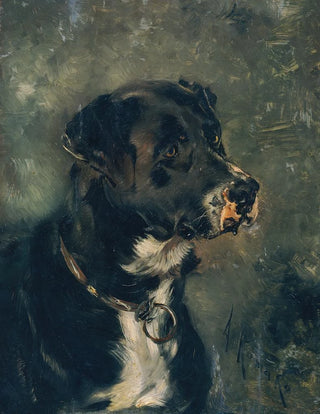Art print | Butcher's dog head Dog head - Anton Romako


View from behind

Frame (optional)
In the fascinating world of art, some works manage to capture the very essence of the human condition through unexpected representations. The "L Head of Butcher's Dog" by Anton Romako is a perfect example. This piece, which transcends the simple boundaries of an animal portrait, invites the viewer to delve into a deeper reflection on nature, life, and death. The way Romako manages to breathe soul into this seemingly mundane subject demonstrates his artistic genius. Observing this artwork, one is immediately struck by how it evokes complex emotions, reminding us that even the most humble subjects can carry immense symbolic weight.
Style and uniqueness of the work
Anton Romako's style is characterized by a realistic approach combined with an impressionist sensitivity. In "L Head of Butcher's Dog," the artist uses delicate brushstrokes and a carefully chosen color palette to bring his subject to life. The texture of the fur, the nuances of shadows, and the depth of the dog's eyes all testify to exceptional craftsmanship. Romako does not merely reproduce a dog; he creates an atmosphere that suggests a story, a past, a personality. The artwork is imbued with emotional intensity that captivates the viewer and encourages prolonged contemplation. Through this representation, the artist prompts us to consider the relationship between humans and animals, while questioning our own place in the natural world.
The artist and his influence
Anton Romako, born in 1848, was an Austrian painter whose work was heavily influenced by the artistic movements of the 19th century. His training at prestigious art schools and his travels across Europe allowed him to refine his unique style, blending realism and impressionism. Romako distinguished himself by his ability to capture fleeting moments and intense emotions, both in his portraits and landscapes. His influence extends beyond his era, inspiring many contemporary artists to explore similar themes. By choosing to depict a dog in such a light, Romako challenges the

Matte finish

View from behind

Frame (optional)
In the fascinating world of art, some works manage to capture the very essence of the human condition through unexpected representations. The "L Head of Butcher's Dog" by Anton Romako is a perfect example. This piece, which transcends the simple boundaries of an animal portrait, invites the viewer to delve into a deeper reflection on nature, life, and death. The way Romako manages to breathe soul into this seemingly mundane subject demonstrates his artistic genius. Observing this artwork, one is immediately struck by how it evokes complex emotions, reminding us that even the most humble subjects can carry immense symbolic weight.
Style and uniqueness of the work
Anton Romako's style is characterized by a realistic approach combined with an impressionist sensitivity. In "L Head of Butcher's Dog," the artist uses delicate brushstrokes and a carefully chosen color palette to bring his subject to life. The texture of the fur, the nuances of shadows, and the depth of the dog's eyes all testify to exceptional craftsmanship. Romako does not merely reproduce a dog; he creates an atmosphere that suggests a story, a past, a personality. The artwork is imbued with emotional intensity that captivates the viewer and encourages prolonged contemplation. Through this representation, the artist prompts us to consider the relationship between humans and animals, while questioning our own place in the natural world.
The artist and his influence
Anton Romako, born in 1848, was an Austrian painter whose work was heavily influenced by the artistic movements of the 19th century. His training at prestigious art schools and his travels across Europe allowed him to refine his unique style, blending realism and impressionism. Romako distinguished himself by his ability to capture fleeting moments and intense emotions, both in his portraits and landscapes. His influence extends beyond his era, inspiring many contemporary artists to explore similar themes. By choosing to depict a dog in such a light, Romako challenges the






